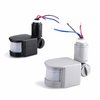Hello, I am having trouble trying to troubleshoot security motion detectors on outdoor lights. Is there a somewhat common way to troubleshoot outdoor security lights? If so where can I get my hands on a copy? I have lights that stay on, lights that won't come on, all types of problems. Can I order motion detectors and install one on the board in the one that comes on when first turned on but that's it until the next night. I do I know what to order and from where? Same with the little eye's on the board, I see dozens on eBay and I need one-three and how do I determine which to buy? I am trying to light up around the chicken houses where my Wife can go feed and gather eggs after dark and the lights be auto.
Also, have predators at night killing chickens and I hope to scare them away with lights coming on when they approach the coops and go off as they leave. There are no power problems it is in the lighting controls I can't afford to replace them but have to do something. If she were to step on a snake then I will inherit the egg gathering and feeding responsibility. Some of the lights are a few years old and some are old unused and the new one will not turn off. I do appreciate any and all help y'all can give me.
Thanks
Also, have predators at night killing chickens and I hope to scare them away with lights coming on when they approach the coops and go off as they leave. There are no power problems it is in the lighting controls I can't afford to replace them but have to do something. If she were to step on a snake then I will inherit the egg gathering and feeding responsibility. Some of the lights are a few years old and some are old unused and the new one will not turn off. I do appreciate any and all help y'all can give me.
Thanks

